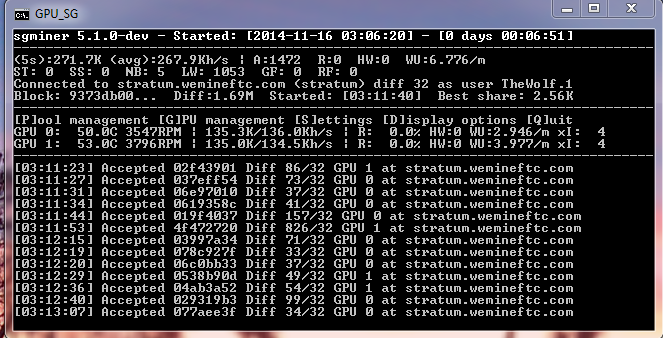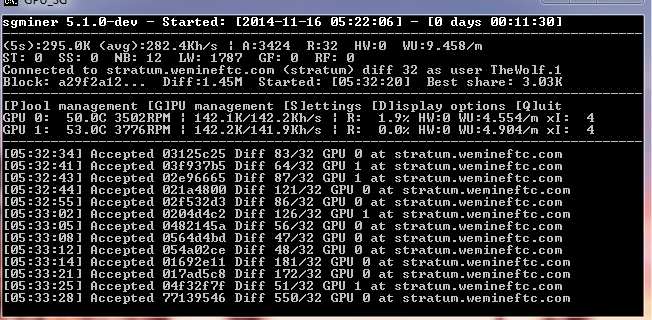[Dev] NeoScrypt GPU Miner - Public Beta Test
-
Not seeing any magic dust in -x for neoscrypt like I did with scrypt mining with the testing I’ve done so far. :-
Pair of R9 270 non X

"xintensity" : "4,4", "vectors" : "1,1", "worksize" : "64,64", "thread-concurrency" : "8192,8192", "gpu-engine" : "1100,1100,", "gpu-memclock" : "1450,1450", "gpu-fan" : "75,75", "gpu-memdiff" : "0,0", "gpu-powertune" : "0,0", "gpu-vddc" : "0.000,0.000", "temp-cutoff" : "90,90", "temp-overheat" : "85,85", "temp-target" : "70,70", "api-mcast-port" : "4028", "api-port" : "4028", "expiry" : "1", "failover-only" : true, "gpu-dyninterval" : "7", "gpu-platform" : "0", "gpu-threads" : "2", "log" : "5", "neoscrypt" : true, "no-pool-disable" : true, "queue" : "0", "scan-time" : "1", "temp-hysteresis" : "3", "shares" : "0", "kernel-path" : "/usr/local/bin", "device" : "0-1"
That’s not bad hash rates for a 270. From what I recall, 270 is very similar to 7850-7870. My 7950 got a 22% increase and 7870 got a 9% hash rate increase using similar settings as you. Obviously, all cards aren’t made equal, and some like these settings, and others don’t.
-
That’s not bad hash rates for a 270. From what I recall, 270 is very similar to 7850-7870. My 7950 got a 22% increase and 7870 got a 9% hash rate increase using similar settings as you. Obviously, all cards aren’t made equal, and some like these settings, and others don’t.
Yes not bad but had hoped I see the same type results here with -xI like I did with LTC/Doge mining.
-I 15 with those the system was unusable from lag but -xI 4 with those same settings above had zero
lag with a nice jump in hash. Max OC would get just over 500kh/s per card the above relaxed settings did
487Kh/s per card 24/7 for more than a year non stop.
Not seeing much difference with the other -w numbers that was posted above +1 -1 is about all.
-
I know this is off topic but what’s the best hash rates anyone can get for NVidia 750ti? Have any of these new kernals etc made any difference to NVidia cards?
-
core 1180 memory 1500 other than that there with the same settings I posted earlier.

-
R9 290x 327-328 Kh/s
I13 g2 tc8192 w192 lookup-gap2
Same, but with rawintensity:
rawintensity8192 g2 tc8192 w192 lookup-gap2
-
now under testing:
280x(hynix) 325khs, clock speed does not matter so much this at 1100mhz, memory 1500mhz
sgminer.exe -k neoscrypt --thread-concurrency 8192 --rawintensity 6144 --worksize 256 -g 4 --lookup-gap 2
ati catalyst 14.11 beta dlls ( no big changes from 14.6rc2 if there is any…)
sgminer 5.1.0dev posted somewhere here, wolfs miner will not work
-
Hehe it is interesting how things are changing, all the things I said and some ppl didn’t believed are writing now. Like I said high Freq is not important and any setting will do as long you use xintensity or rawintensity :) What will happen when I say that kernel will work better when you lower Freq :)
Let’s calculate rawintensity again. Shaders of your card multiply by the best result of xintensity on your card. So for 280x is 2048 x 3 equals 6144 for rawintensity then play with that value, fine tune it.
-
R9 290x 327-328 Kh/s
I13 g2 tc8192 w192 lookup-gap2
Same, but with rawintensity:
rawintensity8192 g2 tc8192 w192 lookup-gap2
Wow, my 290x’s hate those settings, but my 290’s are liking them, found another avenue to research… >:D
-
I have found that the WU is directly related to the difficulty.
In the block factory pool, you can set the difficulty that you want to work at, so I’ve been trying different values as the hashrate has climbed and watched the changes.
My setup (exact same mining settings), with difficulty:
256 will get a WU of around 1.0 to 1.3
128 will get a WU of around 2.3 to 3.5
64 will get a WU of around 220 to 340
But looking at the shares in the pool, the diff of 64 shows the the most erratic hashrate, usually balancing out to a lower average than the higher diff, with lower WU, but overall more effecting hashing.
-
I had a dumb question, and deleted it…
-
aah…
-
Here’s a newer sgminer-5.1.0-dev build (2014-11-13) for everyone:
https://drive.google.com/file/d/0B06N0FYvyFgDMWJ3b1F6VHpoZnc/view?usp=sharing
It includes AMD OCL DLLs from Catalyst 14.6 RC2 (OpenCL 1.2 AMD-APP (1526.3)) and the latest Wolf0 kernel from github.
It includes some bat and vbs files I use to auto delete bins and set environmental variables.
Also has other small fixes from sgminer devs that aren’t neoscrypt related.
Here’s the latest AMD OCL DLL archive I have put together:
https://drive.google.com/file/d/0B06N0FYvyFgDQUdQTjVJeC0xblk/view?usp=sharing
It now has 14 sets of AMD OCL DLLs from Catalyst drivers. 14.6 RC2 is still the fastest.
-
The 290x is a bit of a mystery atm. Not quite sure why an AMD HD7950 can outperform it on neoscrypt.
I think I know.
-
I would be happy to know the answer, as I have 4 GPU’s that get out performed by lesser GPU’s…
-
I would be happy to know the answer, as I have 4 GPU’s that get out performed by lesser GPU’s…
Their compute is too fast relative to memory speed, I think - they need more work. TMTO will help.
-
Time-Memory Trade-Off?
I do think that the extra memory on my 290(x)'s is unused… (not that I know enough to tell for sure, but from what I have tried seems to imply that)
-
Time-Memory Trade-Off?
I do think that the extra memory on my 290(x)'s is unused… (not that I know enough to tell for sure, but from what I have tried seems to imply that)
Yes - use less memory per thread, run more threads.
-
Is this going to take modding the kernel or just changing some variables in it?
-
I think I know.
Of course you do. Wolves are intelligent creatures :)
-
Is this going to take modding the kernel or just changing some variables in it?
SMix has to be modded accordingly. A variable change is needed in the miner, as well.